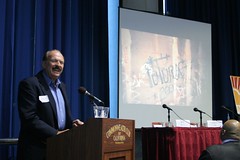Graffiti panel at the Commonwealth Club
August 17, 2005 on 9:55 am | In local news | 3 CommentsLast night’s panel at the Commonwealth Club was pretty interesting. The topic was “Graffiti: Urban Scrawl or Artistic Freedom?”. There was an introduction and slide show by Jim Prigoff, street art historian and coauthor of Spraycan Art. The panelists were: APEX BA of San Francisco street art fame; Ben Morgan, Director of Quality of Life; John Doffing, Founder of Start Soma Gallery; Machaela M. Hoctor, San Francisco Deputy City Attorney; and Mohammed Nuru, Chair of San Francisco’s Graffiti Advisory Board. It was moderated by Jonathon Keats, an Art Critic for San Francisco Magazine.
Jim Prigoff’s introduction was fantastic: he quickly covered the whole history of graffiti, from petroglyphs to the present, making sure to touch on local heroes like Dug, Twist, Reminisce. He also pointed out the absurdity of the fact that PepsiCo can cover a bus with a whole-car ad for sugar water, but when a graffiti writer does the same thing for the sake of public art, it’s a crime.
The questions from the moderator were mostly pretty soft. Apex and the other “pro-graffiti” panelists consistently tried to bring the discussion around to the social issues surrounding graffiti, the deeper problems of which the most destructive vandalism is only one symptom, and the imbalanced nature of our visual environment in which we’re constantly bombarded with corporate messages. John Doffing, who organized the panel, was quite outspoken, and backed up his arguments with some terrific statistics. The “anti-graffiti” panelists tried to paint the issue as black-and-white, regurgitating a narrow interpretation of the legal code: permission makes it legal, and lack thereof makes it a crime. The panelists seemed to be heading for a “diverging consensus”, as Ben Morgan put it. The only thing they all could agree on was that big, colorful pieces are unquestionably art.
During the Q&A afterwards, the discussion started to get a bit more nuanced, with panelists addressing audience questions about the ephemeral nature of the art form, and drawing the important distinction between real graffiti (artistic tags made by writers and crews) and gang graffiti (territory marking by violent gangs, a tiny minority of all tags here in San Francisco.) It was pointed out that under current law, any group of “two or more people who engage in illegal activity for the betterment of the group” constitutes a “gang”. Which means that two kids who get caught writing graffiti together can be punished as severely as an organized gang of violent criminals. This is what black-and-white thinking leads to.
One of the most constructive new ideas came from an audience member, who suggested taking the money currently wasted on repeatedly buffing the same concrete walls (currently about $22 million per year for San Francisco alone!) and allocating it to a public art fund, with one condition: any graffiti-abatement costs incurred during the year would be taken out of the public art fund. The idea is that this would serve as a better deterrent against illegal graf, since writers engaging in it would be taking money out of their own pockets. I’m not sure it would work, but it’s an interesting idea!
3 Comments
Sorry, the comment form is closed at this time.
Entries and comments feeds.
Valid XHTML and CSS. ^Top^
46 queries. 0.137 seconds.
Powered by WordPress with theme based on jd-nebula design by John Doe.

Despite the fact that used a very nice picture of me (smile) I thought this was a very accurate and informative report for the evening. Thanks for doing it.
Comment by Jim Prigoff — October 1, 2005 #
Mr. Prigoff,
During recent travels I encountered an interesting turn of events in Dillon, Montana. In order to, “preserve a proper community image”, a Corporate Executive (Winston Fly Rods) and a Lutheran congregation took up rollers and completely covered some amazing work (over 20 large and detailed pieces requiring 8 to 14 hours each) that were done by an invited group of writers (hailing from Iowa to L.A.) during a late Fall Urban Arts Festival. Protestors tried to fend off the defacing crew but, to no avail, were not heard. In the end a bomb threat, yep bomb threat, forced both painters and protestors clear from the building. Thankfully nobody was hurt. 50% of the Arts Festival work remains uncovered but has been approved to be covered once weather permits. Drop me an email to request photos of quality no-pressure work never to be seen again.
Comment by Chris G. — November 28, 2005 #
A link to a discussion of the censorship in Dillon.
http://outdoorsbest.zeroforum.com/zerothread?id=420651&postid=4943889#4943889
Comment by MTgrayling — December 4, 2005 #